What was the best part of your PolarTREC experience?
Since coming home I’ve been asked several times, “What was the best part of your PolarTREC experience?”, and I’ve been stumped to come up with an answer. I really haven’t been able to narrow it down to just one moment or learning experience. Every part of my Arctic research expedition journey, beginning with the supportive professional development we were part of at the PolarTREC orientation back in February, through the time spent in Barrow conducting research and working with my incredibly talented, tireless and good-humored expedition team of Dr. Carin Ashjian, Dr. Robert Campbell, Dr. Steve Okkonen and captains Bill Kopllin and Mike Fleming, has been absolutely amazing.
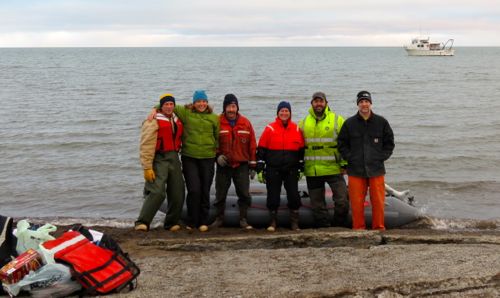 PolarTREC Expedition Team Final Day in Barrow! Final photo opportunity before wishing Dr. Okkonen and Captains Bill Kopplin and Mike Fleming bon-voyage for their trip aboard the R/V Ukpik back to Prudhoe Bay! Left to right: Dr. Steve Okkonen, Lisa Seff, Bill Kopplin, Dr. Carin Ashjian, Mike Fleming, Dr. Bob Campbell. September 10, 2012.
PolarTREC Expedition Team Final Day in Barrow! Final photo opportunity before wishing Dr. Okkonen and Captains Bill Kopplin and Mike Fleming bon-voyage for their trip aboard the R/V Ukpik back to Prudhoe Bay! Left to right: Dr. Steve Okkonen, Lisa Seff, Bill Kopplin, Dr. Carin Ashjian, Mike Fleming, Dr. Bob Campbell. September 10, 2012.
Sharing our Arctic research-based lesson activities with students and teachers in the Barrow and Point Hope schools was icing on the cake!
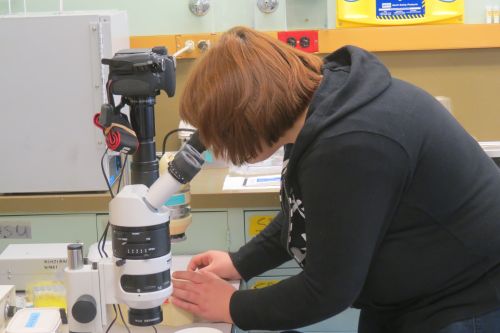 Barrow High School student Alex Rabadjiysky visits our Barrow lab at NARL as part of the Barrow Arctic Science Consortium field trip with Abra Bekker and checks out krill and copepods on the microscope. September 7, 2012. Photo by Lisa Seff.
Barrow High School student Alex Rabadjiysky visits our Barrow lab at NARL as part of the Barrow Arctic Science Consortium field trip with Abra Bekker and checks out krill and copepods on the microscope. September 7, 2012. Photo by Lisa Seff.
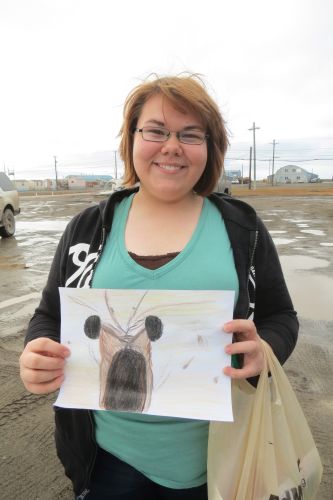 Alex's artwork after viewing krill in the microscope. September 7, 2012. Photo by Lisa Seff.
Alex's artwork after viewing krill in the microscope. September 7, 2012. Photo by Lisa Seff.
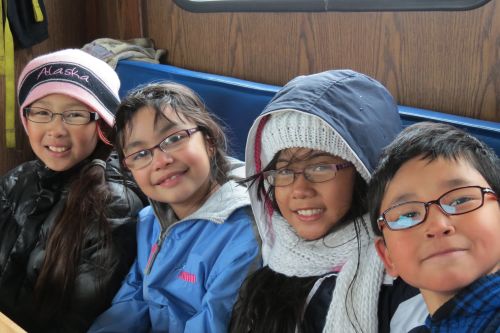 Barrow Ipalook Elementary School students get a tour of the R/V Ukpik with PolarTREC educator Lisa Seff. September 6, 2012. Photo by Lisa Seff.
Barrow Ipalook Elementary School students get a tour of the R/V Ukpik with PolarTREC educator Lisa Seff. September 6, 2012. Photo by Lisa Seff.
 Final goodbyes after our wonderful visit in Point Hope with the Tikigaq School students, teachers and community! Left to right: Lisa Seff, Point Hope educator Cristina Castillo and Dr. Carin Ashjian. September 15, 2012. Photo by assistant principal Marlene Beam.
Final goodbyes after our wonderful visit in Point Hope with the Tikigaq School students, teachers and community! Left to right: Lisa Seff, Point Hope educator Cristina Castillo and Dr. Carin Ashjian. September 15, 2012. Photo by assistant principal Marlene Beam.
My response until now has been that I couldn’t pick just one “best part” moment because they are all woven together into a complex tapestry of one amazing science-based learning and life experience. However after arriving home and coming back to school for the last few weeks, clearly one part has begun to stand out. I can now say that the best part of my PolarTREC experience has been the impact that it has had on my own teaching and on everyone who has joined me on this journey, including my own students and community members.
Live with PolarConnect!
I was told that the excitement was palpable as our principal observed classrooms throughout the school while more than 500 students and staff joined us online with our live PolarConnect research discussion from Barrow on September 7th, 2012. What an amazing group experience! Across all content area's and grade levels in our school, students and teachers engaged across the miles with our research team in Barrow to learn about the oceanographic conditions in the Arctic. Community members also tuned into the discussion, including a group at the East Hampton Town Senior Citizens Nutrition Center!
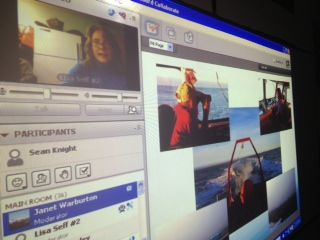 PolarConnect Event at Springs School from Barrow Alaska! September 7, 2012. Photo courtesy of Eric Casale.
PolarConnect Event at Springs School from Barrow Alaska! September 7, 2012. Photo courtesy of Eric Casale.
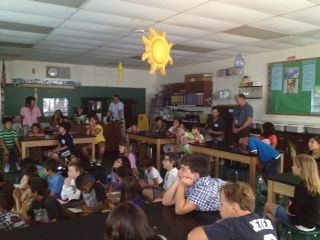 Springs School students in one of Mr. Knight's elementary science classes engaging in our PolarConnect Event from Barrow Alaska. September 7, 2012. Photo courtesy of Eric Casale.
Springs School students in one of Mr. Knight's elementary science classes engaging in our PolarConnect Event from Barrow Alaska. September 7, 2012. Photo courtesy of Eric Casale.
 Springs School students in Mr. Hallman's kindergarten library class. PolarConnect Event from Barrow Alaska. September 7, 2012. Photo courtesy of Eric Casale.
Springs School students in Mr. Hallman's kindergarten library class. PolarConnect Event from Barrow Alaska. September 7, 2012. Photo courtesy of Eric Casale.
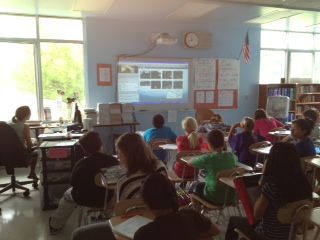 Springs School students in Mrs. O'Reilly's middle-school english class. PolarConnect Event from Barrow Alaska. September 7, 2012. Photo courtesy of Eric Casale.
Springs School students in Mrs. O'Reilly's middle-school english class. PolarConnect Event from Barrow Alaska. September 7, 2012. Photo courtesy of Eric Casale.
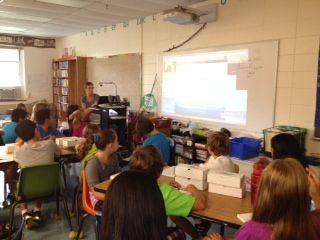 Springs School students in Mrs. Frazier's 5th grade class. PolarConnect Event from Barrow Alaska. September 7, 2012. Photo courtesy of Eric Casale.
Springs School students in Mrs. Frazier's 5th grade class. PolarConnect Event from Barrow Alaska. September 7, 2012. Photo courtesy of Eric Casale.
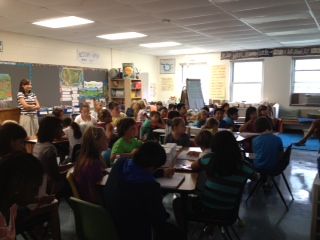 Springs School students in Ms. Capatosto's 5th grade class. PolarConnect Event from Barrow Alaska. September 7, 2012. Photo courtesy of Eric Casale.
Springs School students in Ms. Capatosto's 5th grade class. PolarConnect Event from Barrow Alaska. September 7, 2012. Photo courtesy of Eric Casale.
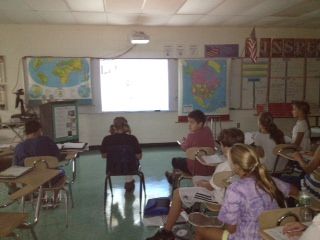 Springs School students in Mrs. Turner's middle-school social studies class. PolarConnect Event from Barrow Alaska. September 7, 2012. Photo courtesy of Eric Casale.
Springs School students in Mrs. Turner's middle-school social studies class. PolarConnect Event from Barrow Alaska. September 7, 2012. Photo courtesy of Eric Casale.
 One of my own 8th grade science classes joining us in Barrow during our PolarConnect event, along with my substitute teacher Diane Mehrhoff at the helm! September 7, 2012. Photo courtesy of Eric Casale.
One of my own 8th grade science classes joining us in Barrow during our PolarConnect event, along with my substitute teacher Diane Mehrhoff at the helm! September 7, 2012. Photo courtesy of Eric Casale.
Ring-Net In The Water!
Sunday, one week following my return from my PolarTREC Arctic research expedition, I was already suffering from a lack of daily research experiences and I found myself going out on our local bay, Three Mile Harbor with a plankton ring-net in hand. Just so you know, this was a first! I didn’t have a cod-end available so I jury-rigged one with a pair of nylons from my winter wardrobe and a plastic cup. It worked rather nicely and I ended up with a container filled with local plankton samples!
 One week post-expedition! Lisa Seff with ring net in hand, collecting plankton for next days student microscope lab in Three Mile Harbor, East Hampton New York. September 23, 2012. Photo by Gary Seff.
One week post-expedition! Lisa Seff with ring net in hand, collecting plankton for next days student microscope lab in Three Mile Harbor, East Hampton New York. September 23, 2012. Photo by Gary Seff.
 Ring net plankton tow in Three Mile Harbor East Hampton New York. September 23, 2012. Photo by Lisa Seff.
Ring net plankton tow in Three Mile Harbor East Hampton New York. September 23, 2012. Photo by Lisa Seff.
Best Science Class Ever!
At school the next day I replaced my regular Introduction to the Microscope Lab, where students would usually learn to use their microscopes by analyzing a letter “e”, and replaced it with an Introduction to the Microscope and Plankton Lab. This lab included zooplankton and phytoplankton identification activities using the plankton-tow samples I’d collected the day before, along with a computer-linked microscope and supplies borrowed from the Center for Microbial Oceanography. Students were over-the-top with enthusiasm. I’ve never seen that level of excitement and focus and been pulled in so many directions all at once during a classroom lab. They learned how to use the microscope all while discovering the amazing animals and plants that live in their own back yard harbor. Shouts rang through the classroom as they recognized some of the zooplankton as copepods based on photographs I had shown them from our Arctic expedition samples. One boy remarked that it was the best science class ever. How awesome is that!
 Just one of the copepods that Springs students found in our Three Mile Harbor plankton-tow water samples. September 24, 2012.
Just one of the copepods that Springs students found in our Three Mile Harbor plankton-tow water samples. September 24, 2012.
 Zooplankton (sub-phylum crustacea) that Springs students found in our Three Mile Harbor plankton-tow water sample. September 24, 2012.
Zooplankton (sub-phylum crustacea) that Springs students found in our Three Mile Harbor plankton-tow water sample. September 24, 2012.
First Day Back At School!
Finally, I want to describe my initial re-entry moment back into Springs School just two days after returning from my PolarTREC expedition. I arrived back at school for the first time to attend our middle school Open House in the late afternoon on Tuesday September 18th. As I juggled to carry a load of baleen, books and backpacks a student from one of the younger grades, who I didn’t know previously, swung the door open for me and added a loud, "Hi Mrs. Seff, welcome back! How was Alaska?" “It was great!” I replied, smiling because although I didn’t know him, he obviously knew me from our PolarTREC experience! He then asked what I was carrying and I explained that it was baleen from the mouth of a bowhead whale. I continued with, "the whale uses the baleen to filter feed.....", but before I could finish my sentence he practically exploded with excitement and shouted out, "Krill! They're a type of plankton that the whale eats!"
I paused and looked around…wondering if this too good to be true moment was a set-up…
It wasn't.
I couldn't think of a better way to be welcomed home to Springs School!

